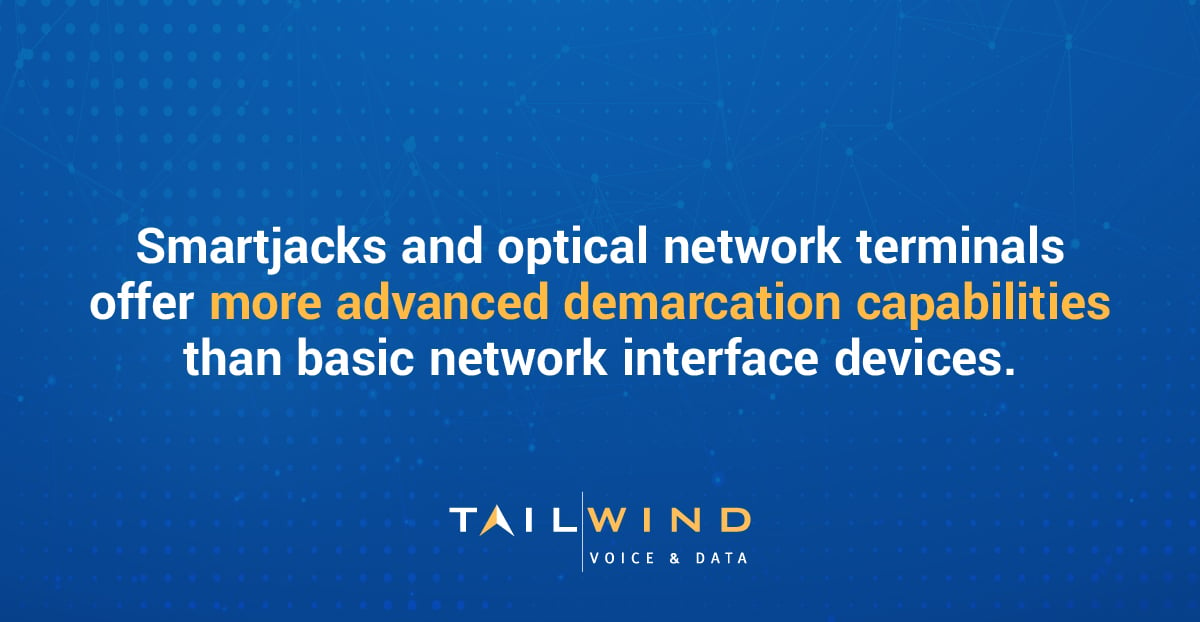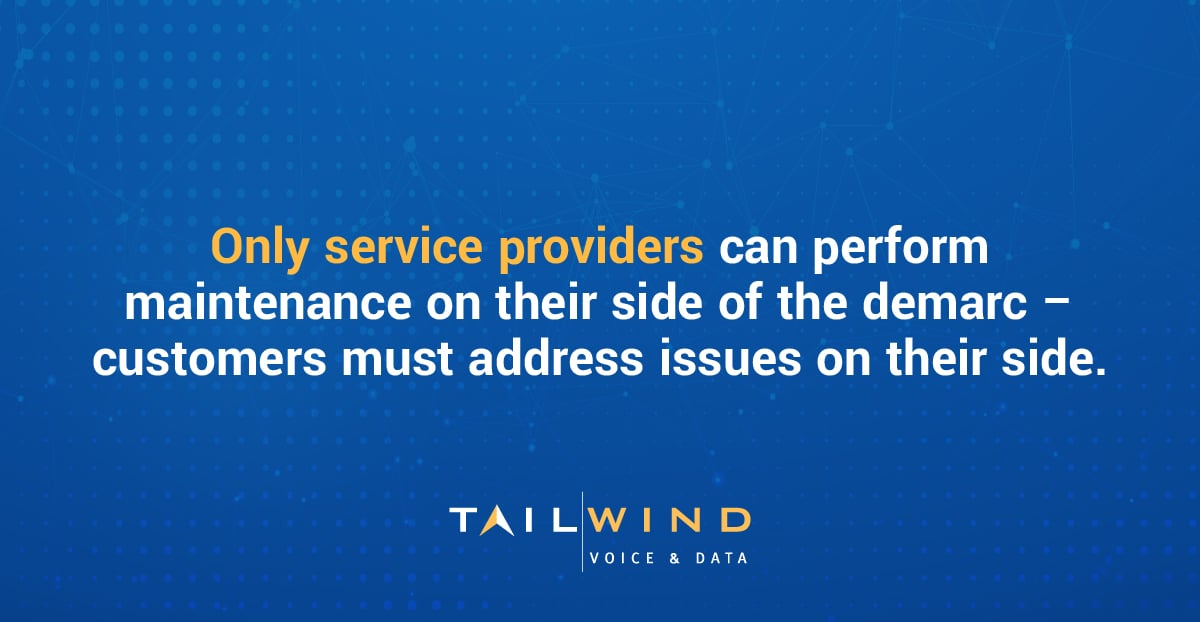A demarcation point, or demarc, is a vital component in any business communications infrastructure. This junction separates the public switched telephone network (PSTN) from your building's telecommunications infrastructure. When you have a clear demarcation between the equipment owned by your telecom provider and your organization's private network, it minimizes confusion over responsibility.
With structured cabling powering more advanced voice, data, and video applications than ever, a properly implemented demarc point is crucial. In this guide, we’ll cover everything you need to know about demarcation points and their role in enterprise networks to help you optimize your cabling and connectivity.
What Is A Demarcation Point Or Demarc?
A demarcation point, known as a demarc, is the physical boundary where a telecommunications provider’s network ends and a customer’s internal wiring begins. It marks the shift in responsibility, from the provider to the property owner, for maintaining and troubleshooting the network connection.
Key Components Of A Demarcation Point
A demarcation point isn't just a boundary, it's a structured setup that ensures smooth handoff and maintenance between telecom providers and business networks. Typical components found at the demarc include:
Demarcation Box or Panel
A weatherproof enclosure that houses and protects the demarcation hardware from environmental damage.
Circuit Protection
Devices like surge protectors, gas discharge tubes, and carbon blocks safeguard equipment from electrical surges and provider-side interference.
Cross-Connect
A physical interface where the provider’s lines connect to the customer’s internal wiring, enabling easy rerouting or disconnection if needed.
Test Jack
Often an RJ11 port, this allows quick testing of the provider’s line to isolate issues without interfering with internal systems.
Backup Battery
Common in fiber or advanced connections, backup power keeps communication services active during brief outages.
These components not only define where the provider's responsibility ends but also simplify troubleshooting, upgrades, and network maintenance.
History Of Demarcation Points
The demarcation point traces its origins back to the early 20th-century telecommunications industry. Up until the 1980s, the Bell System Companies (AT&T) owned all the telephone wires, switches, and equipment associated with the phone network in the U.S. After the antitrust breakup of the Bell System in 1984, “Baby Bell” telephone companies were formed, and the demarcation point was mandated.
Since customers no longer had to get phone systems from AT&T exclusively, the demarcation point was integral to determining which portion of the network was owned by a customer and which was the responsibility of the telecom company. Phone and internet service providers are accountable for repairing issues up to and including the demarc. Beyond that point, the customer must fix any wiring problems independently.

What Are The Primary Demarcation Point Types?
There are several common types of demarcation point devices used in enterprise facilities, including:
Network Interface Device (NID)
NIDs, the most basic type of demarcation point, are typically weatherproof boxes mounted on the exterior of a building. They contain minimal components, including wiring termination blocks, RJ11 jacks, surge protection, and a test jack for troubleshooting. NIDs provide a simple, low-cost demarcation point solution for basic voice and data services but lack the advanced functionality of smartjack and optical network terminal demarcs.
Smartjack/Intelligent Network Interface Device (INID)
Smartjacks, or INIDs, offer more sophisticated demarcation capabilities for higher-bandwidth connectivity. They contain additional telephone equipment components like circuit boards and switching hardware beyond the basic wiring of NIDs. Smartjacks are capable of supporting more complex telecom services like T1 lines and can strengthen signal quality through functions like signal repeating and reclocking. Smartjacks also enable phone companies to remotely test customer wiring without a site visit.
Optical Network Terminal (ONT)
An optical network terminal, or ONT, is a type of demarcation point designed for fiber optic cabling interconnects. ONTs leverage fiber optic cables for high-speed broadband services and convert optical signals to electrical signals for building wiring compatibility. However, ONTs require backup battery power since fiber can't pass electrical current. While less common, ONT demarcs are expected to increase as more enterprises deploy fiber networks.
What Are The Benefits Of Demarcation Points?
Demarcation points clearly define the ownership and responsibilities of different parts of a phone system network. Thanks to this delineation, businesses can enjoy benefits such as:
Component Protection
Demarcs contain surge protectors that shield cabling and devices from potentially damaging electrical surges coming in from the outside lines, preserving the integrity of customer premises equipment.
Simplified Troubleshooting
Businesses can easily disconnect their internal wiring from the provider side at the demarc jack to determine if connectivity problems originate from external lines or internal phone system infrastructure.
Added Redundancy
Demarcs can help prevent telephone network outages by providing fault propagation features that automatically reroute traffic when one provider link fails.
Service Flexibility
The demarc allows customers to connect phone system equipment from any vendor to the public network. Without a demarc, customers would have limited provider options.
Support For Advanced Services
Demarcs contain additional components like Network Termination Units to support the implementation of advanced services like Integrated Services Digital Network (ISDN).
Stronger Security
Specialized demarc equipment can provide enhanced security features to protect business phones, such as additional network access controls or traffic encryption.

What Is A Demarc Extension?
A demarcation point extension, or demarc extension, may be required to connect a telephone network service's point of entry with a business's internal wiring. When the demarc is too far from your telecom closet or equipment, providers will install additional cabling from the demarc to your equipment located onsite.
Demarc extensions are typically performed by a qualified structured cabling technician when a business needs new phone services or wants to upgrade its OSP. They can vary from simple to complex depending on the organization's specific communication needs.
- A simple demarc extension involves running wiring from the telecom closet to the customer's equipment room.
- More advanced projects can involve expert project management, support testing, and turning up new circuits to ensure they work properly.
What Is Demarc Standardization?
Standards for implementation and demarc extensions still lack uniform national or global guidelines. Inconsistency can lead to poor cabling practices that complicate moves, adds, and changes. Efforts are ongoing to enact more standardized demarcation point requirements.
Consistent standards would reduce confusion and ensure future-proofing. However, as long as your provider follows industry best practices for design and installation, your enterprise demarcation should offer reliability. Partnering with an experienced structured cabling contractor is the best way to guarantee a robust demarcation solution.
Demarcation Point FAQs
Here are answers to a few frequently asked questions about demarcation points:
Can I Perform Maintenance On The Demarc Myself?
Only your telephone company can service their wiring and equipment up to the network demarcation point. You may be able to do limited testing on your side, but be sure to contact a professional for any repairs.
Where Is The Demarc Located?
The demarc is usually on an exterior wall or inside a main telecom closet. The location varies, but it should always be easily accessible.
What Is Global Demarcation?
Global demarcation refers to using demarcation points to organize the responsibilities and ownership of telecom networks on a global scale. It aims to separate the responsibilities of phone service providers and customers in different countries or regions.
Are Demarcation Points Required For Every Network?
Demarcs aren't required for every type of network, but they can be useful in defining the ownership of different parts of an IT network or system.
What If There’s An Issue With My Demarcation Point?
Contact your provider if you suspect a problem since they're responsible for diagnosing issues on their side. If an issue is on your side of the network boundary point, addressing it is your responsibility – though you might consider hiring a professional for assistance.

Tailwind: Your Trusted Partner For Demarcation Point Extensions
As your business looks to future-proof its telecom infrastructure, a professional demarc extension may be required. Unfortunately, relying on phone carriers alone for demarc extensions can result in delays and additional costs – and an improperly executed extension can negatively impact the performance of your voice and data circuits.
If it's time to upgrade your communications network, TailWind can help. Our experts will take complete ownership of your demarc extension project. We'll coordinate directly with your carrier to get your installation done in a timely manner and provide ongoing status updates to ensure no surprises. While we’re onsite, we’ll test and turn up your circuit extension to ensure it's usable and there's no delay.
Keep your connectivity upgrades on time and within your budget with TailWind’s start-to-finish demarc extension services. Contact us today to get started!


